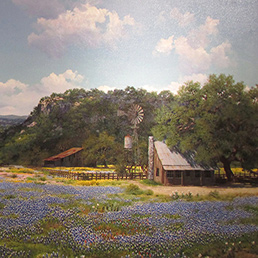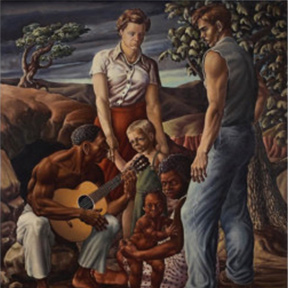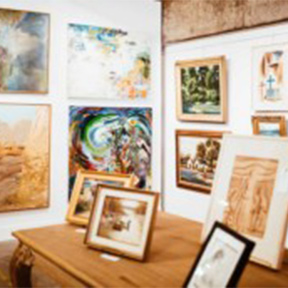- (214) 720-4044
- info@daviddike.com
- Mon - Fri: 10 am - 5 pm
Eisenlohr, Edward
Edward Eisenlohr
Edward G. Eisenlohr moved from Cincinnati, Ohio, to Dallas, Texas when he was two years old. Cultured parents gave him certain advantages, and he attended a preparatory school in Zurich, Switzerland from 1887-1889. After returning to Dallas, he was employed as a bookkeeper for the American Exchange National Bank. By 1907, he had received early training with Frank Reaugh and Julian Onderdonk, a former pupil of William Merit Chase. He spent weekends and holidays drawing, painting and supporting the establishment of art organizations in Dallas. His early work consisted of landscapes and country homes of the areas of Oak Cliff and surrounding parts of Dallas. His early works “portray a quiet, meditative view of nature.”
Taking a nine month leave of absence from his position at the bank, Eisenlohr made plans to tour European museums and galleries. While in New York, he learned that an untitled landscape painting had been accepted for the “Fourteenth Annual Exhibition of American Art” at the Cincinnati Museum of Art.
He then resigned from the bank and spent the summer of 1907, studying with Birge Harrison (1854-1929) at the Art Students League summer school in Woodstock, New York. Harrison believed “art had nothing to do with things as they are, but only with things as they appear to be… the fleeting intangible ever shifting appearance, the mood was important.”
Leaving for Europe in August of 1907, Eisenlohr traveled and sketched in Holland and Belgium. He later enrolled as a master pupil of Gustave Schoenlebr (1851-1917), a graduate of Munich University, who was known as “the greatest and most delicate reproducer of the scenery of the Upper Rhine.”
Eisenlohr, also, took classes from Hans Thoma and Wilheim Truebner. Hans Thoma (1839-1924) was a professor at the Karlsruhe Art Gallery, Karlsruhe, Germany, from 1899-1919. Thoma, a lithographer and landscape painter, was widely acclaimed as the poet-painter of Germany. His solidity of color and precise observation was found in traditional German realism. Wilhelm Truebner (1851-1917), who taught at the Karlsruhe Academy of Art from 1903-1917, is indebted in his early work to Impressionism. Truebner was a founding member of the Berlin Secession, and a member of the Munich Secession. Both organizations were known for advocating naturalistic plein-air painting. The traditions of the Munich School and the development of the German Impressionism had a lasting effect on Eisenlohr’s work. After studying with Truebner, Thoma, and Schoenleber for the 1907-08 academic year, Eisenlohr left Germany to sketch in Switzerland, Italy, France, and England. Completing his grand tour in the fall of 1908, he returned to Oak Cliff and began his career as an artist.
In April of 1903, Eisenlohr exhibited his European paintings and drawings at “The First Annual Exhibition of the Work of Dallas Painters” at the Free Public Art Gallery in Dallas. Eisenlohr began making regular sketching trips to locations near his home. Preferring to draw or paint in the plein air tradition, he stated, “If you can’t find a landscape worth painting within ten miles of where you are, no matter where you are, then you shouldn’t be a painter. There is much to paint here. Dallas sits waiting for her artists to put her on the canvas.”
Although he had been painting with oils for a number of years, between 1910 and 1920, Eisenlohr began working with watercolor and contributed to several national watercolor exhibitions. Using soft, muted color schemes, the watercolor paintings retained his “exquisite craftsmanship and the ambiance of his earlier pencil drawings.”
In his oil paintings, Eisenlohr used rich strokes of paint in warm color tones to establish form and light. As his own Impressionist style began to emerge, Eisenlohr’s paintings were accepted for national exhibitions at the Corcoran Gallery of Art, Washington D.C., in 1916, The National Academy of Design, New York, in 1920, and for a solo exhibition given by the Highland Park Society of Arts in Dallas in March of 1926.
Pleased with the acclaim that he was receiving for his work, Eisenlohr decided, in 1919, to live in Santa Fe and Taos, during the summer months. While in New Mexico, he completed works in pencils first lithograph of New Mexico adobes, which he later exhibited with the Dallas Print Society and the Lone Star Printmakers. Between 1932 and 1940, Eisenlohr exhibited at the Museum of Modern Art, New York, The New York World’s Fair, the Paris International Exhibition, the Venice Biennial, the Dallas Public Art Galleries, Sartor Galleries, Dallas, Texas, and the Witte Memorial Museum, San Antonio, honored him with solo exhibitions. In 1952, as a tribute to the well known and respected artists, a bronze scepter of Edward G. Eisenlohr by Allie Tennant was donated to the Dallas Museum of Art.
The paintings, drawings and lithographs of Edward G. Eisenlohr were acquired by prominent Dallas families, as well as, museums in Texas, New Mexico, and Louisiana. He portrayed country homes with open fields near gigantic old trees that acted as sentinels in the landscape. Occasionally, the changes wrought by man in the name of progress, were depicted, as well. Edward Eisenlohr had found many landscapes worth painting.





